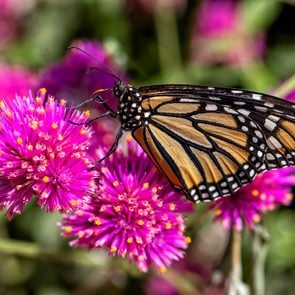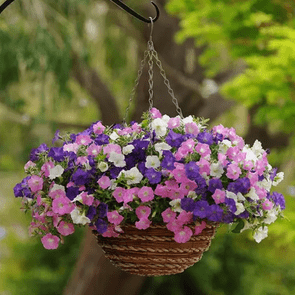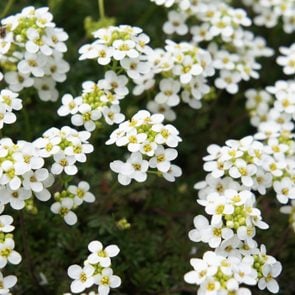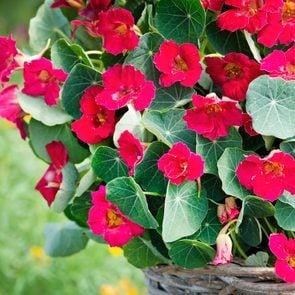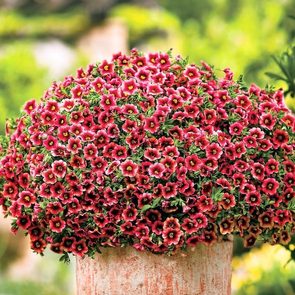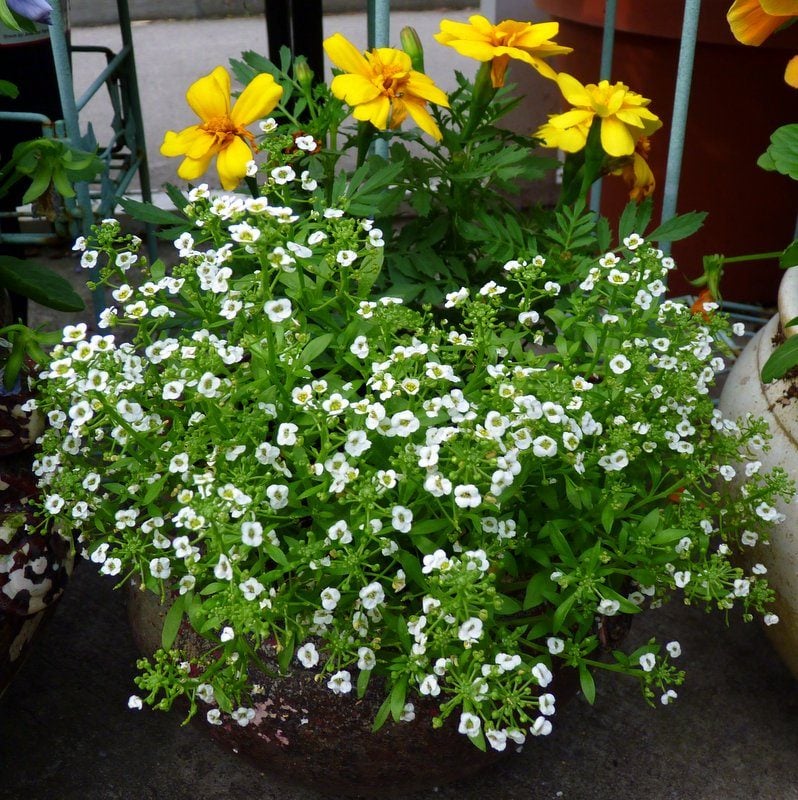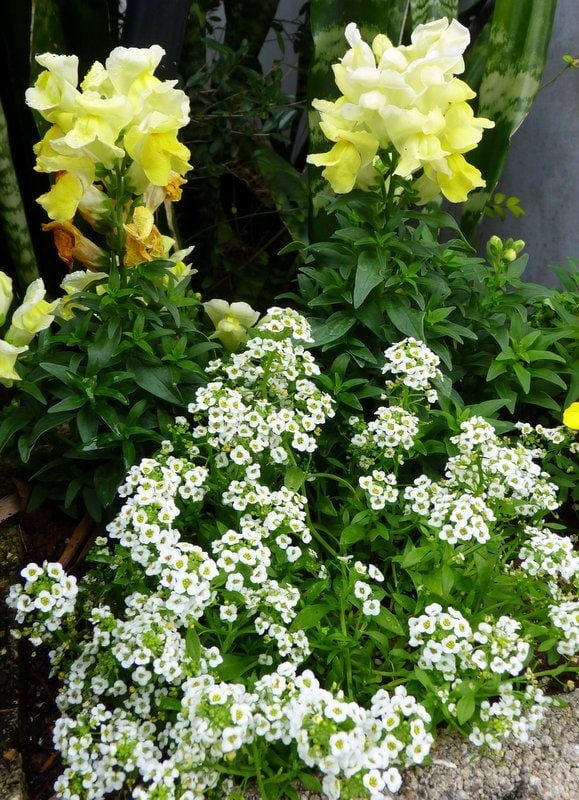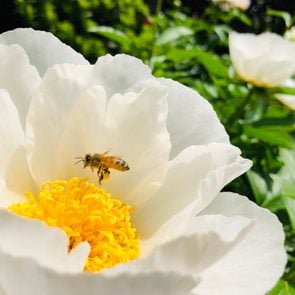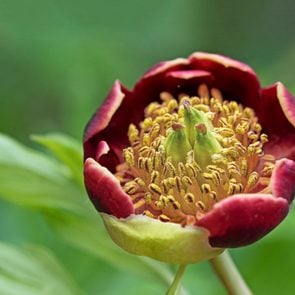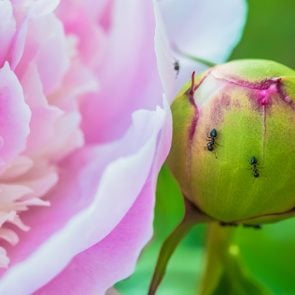Violas Love Cool Weather
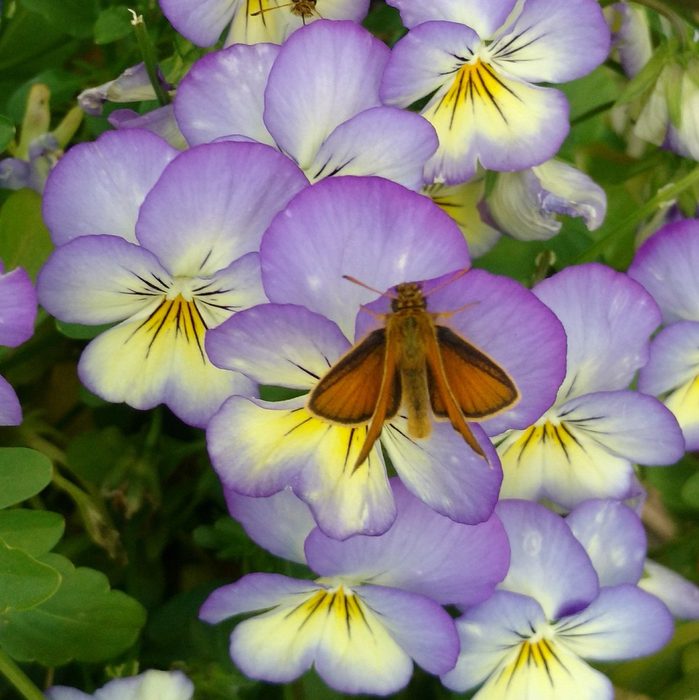
As the garden season winds down up north, in Central Florida, it’s the most wonderful time of year! I was thrilled to visit my local garden center last week and see that the first violas and pansies had arrived. I quickly filled my cart and headed home to fill my flower garden with these colorful cool-season annuals. Learn why you should add one (or more!) viola flower varieties to your garden.
Check out more early blooming spring flowers for your garden.
Viola Flower Care
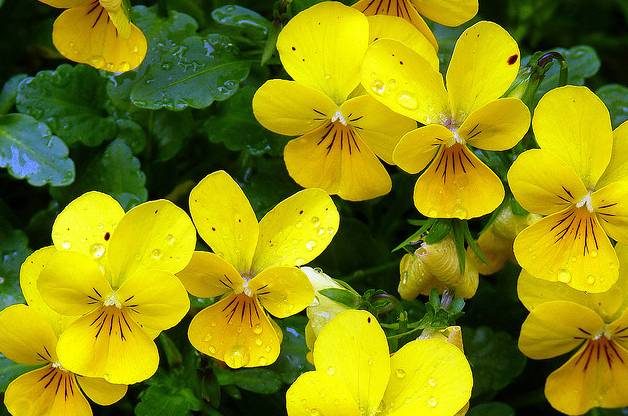
Violas, also known as Johnny-Jump-Ups, are a member of the very large violet family, one of many in the genus Viola. The small blooms frequently sold as viola flower plants may be Viola tricolor or Viola cornuta or a hybrid of the two. They are native to Europe, where they’re a common wildflower.
Violas come in a variety of colors, ranging from purple to orange to yellow to white, and many bi-color combinations of these. They can’t tolerate the high heat of summer, so they are usually grown in spring and early summer in northern climates, and fall through spring down south. Many people think the blooms look like smiling faces, which leads to their appeal.
When planted in fall, these cold-hardy flowers often overwinter to bloom the following year.
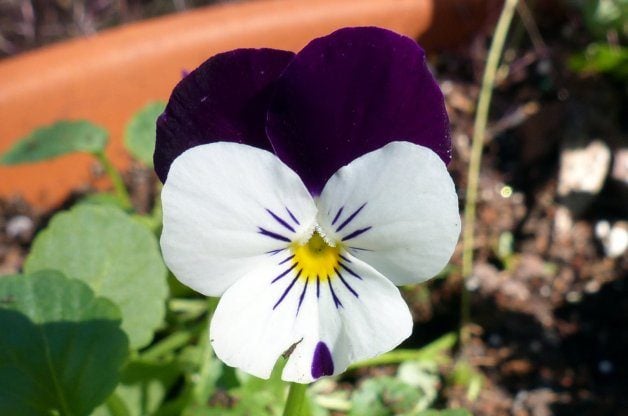
Plant violas in part shade, which will help them last a little longer when temperatures rise. They need regular watering, and can be deadheaded to increase flowering. In many areas, violas self-seed easily. This can make them a bit of a pest if they’re growing where you don’t want them. In that case, consider growing them in pots where you can have more control over them.
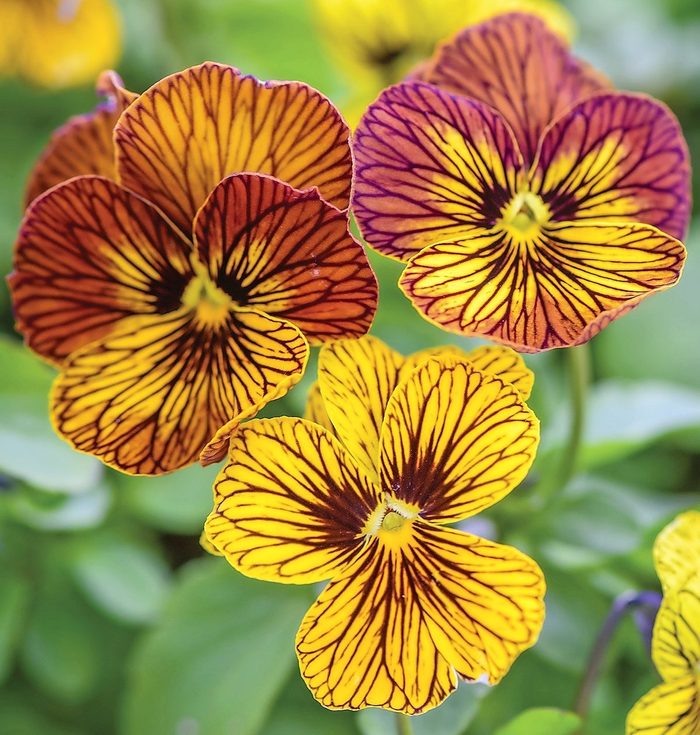
Violas are easy to grow from seed, and are often one of the first flowers ready to set out in the spring up north. Seed catalogs offer a variety of colors, with new ones such as Tiger Eye Violas appearing on the market all the time. Most gardeners wouldn’t consider a cool season flower garden complete without these easy-to-grow cheerful blooms.
Check out the top 10 annuals that attract hummingbirds.
Viola Flowers Are Edible
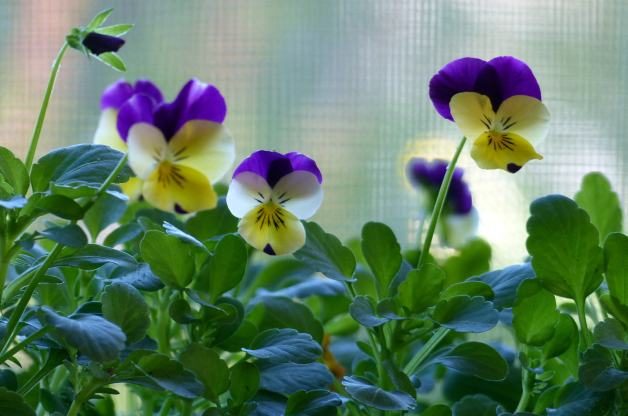
An extra bonus? These blooms are edible and make a lovely garnish for salads or baked goods. Be sure no pesticides or other harmful chemicals have been used on the flowers, though.
Next, learn the difference between annuals vs. perennials.
Why Grow Beacon Impatiens?

Aside from their beauty and shade tolerance, there’s one key reason to go with Beacon Impatiens: disease resistance. In recent years, Impatiens walleriana flowers suffered from a major outbreak of impatiens downy mildew (IDM). The disease was so widespread and decimating that many gardeners were forced to stop planting the flowers altogether. Even worse, the disease could overwinter in the soil. This means it could infect new flowers from growing season to growing season.
Learn how to get rid of powdery mildew.
However, these blooms scoff at downy mildew. Specifically bred to resist the disease, they’re meant to have a high tolerance for IDM. On the whole, they should not be affected by the ailment that’s plagued Impatiens walleriana for more than a decade.
New Guinea impatiens is another bold pick for shady areas.
Care and Growing Tips

Common Name: Beacon Impatiens
Scientific Name: Impatiens walleriana
Zones: 9 to 11, annual if grown elsewhere
Size: 10 to 12 inches tall and 12 to 14 inches wide
Soil Needs: Fertile, well-draining soil
Light Needs: Full to part shade
These flowers are the perfect pick for a shade garden. They’ll add a perky pop of color to anywhere the shadows need some brightening up. The plants are tough and can survive a variety of conditions, but they do need watering when the soil becomes dry. Container grown plants will dry out more quickly. The Beacon Impatiens website recommends fertilizing the plants every 4 to 5 weeks with a balanced liquid fertilizer.
Check out the top 10 annuals that attract hummingbirds.
Beacon Impatiens Colors
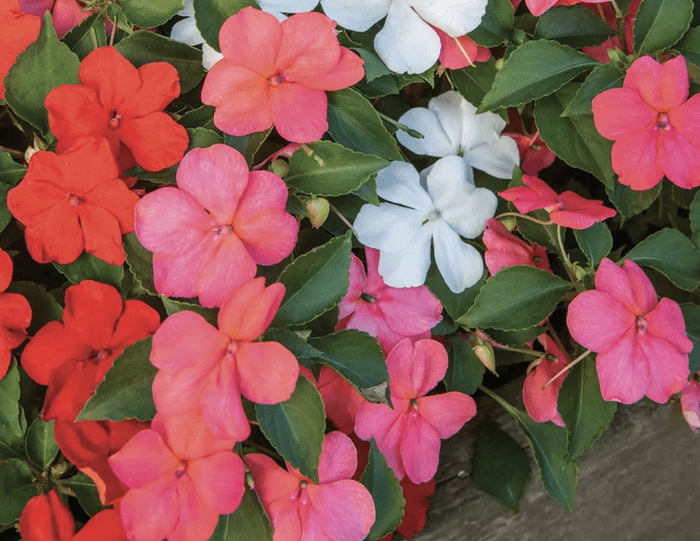
Introduced for the 2020 growing season, Beacon Impatiens are now widely available in a variety of eye-catching hues. You can find them in six colors: bright red, violet, salmon, orange, white and coral. Some growers sell a mix of several shades to add multicolored flair to your yard.

When you have a small yard, you take advantage of every bit of growing space. This past spring, I added a wood lattice trellis along my neighbor’s board fence so I could have some pretty blooms to look at instead of a blank wall of wood. On the recommendation of a friend, I decided to try growing black-eyed Susan vine on the trellis. I started it from seed and was pleased with both how easy it was to get going, and how very fast it took off!
Discover easy ways to use vining plants all around your garden.
Black-Eyed Susan Care Tips
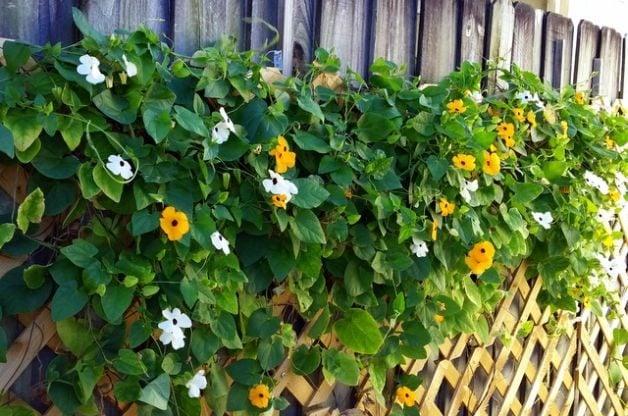
- Black-eyed Susan vine
- Thunbergia alata
- Zones 9 to 10 or Annual
- Attracts bees, butterflies and hummingbirds
- Moist soil
- Full sun
This vine (Thunbergia alata) isn’t closely related to the other familiar native black-eyed Susans (Rudbeckia), but they share a similar coloration. Black-eyed Susan vine is a tropical plant native to Africa that has become a garden favorite. Pollinators love it, too! It isn’t particularly cold hardy, so anyone north of zone 9 has to grow it as an annual.

Fortunately, it’s easy to start from seed. For greater success with germination, soak the seeds in warm water overnight before planting. Transplant seedlings outdoors after the last frost. Northern gardeners can enjoy a beautiful container of trailing black-eyed Susan vine by mid-summer. You can also train it to climb a fence or trellis and use it as a groundcover. Plant in full sun to get the most flowers.
The University of Wisconsin Extension advises that gardeners should use caution before planting this vine in frost-free areas, as it may become invasive.
Check out the top 10 vines for hummingbirds.
Black-Eyed Susan Vine Colors
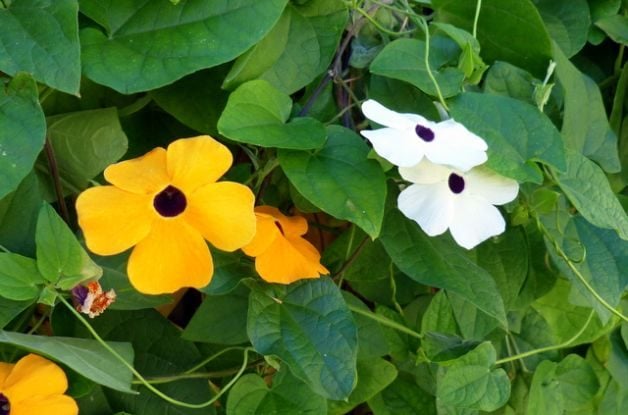
There are multiple cultivars to choose from with yellow and white flowers. There’s also a version called ‘Blushing Susie,’ that looks like the colors of a sunset sky. I’m planning to get my hands on some of these seeds to start soon, since I’ve had such luck with the yellow and white ones.
Looking for more vining plant options? Check out our list of fast growing vines and climbing flowers.
Blue Salvia Pollinator Benefits

If you want to draw in a crowd of pollinators, Playin’ the Blues salvia will pack the stands with them. Hummingbirds, bees and butterflies are all drawn to its purple-blue flowers, which bloom shortly after planting and last until the first hard frost. Native bees are so abuzz about this blue salvia that one grower recommends positioning the plant away from seating areas!
Discover the top 10 salvias hummingbirds love the most.
The plant is convenient and beneficial from a gardening standpoint, as well. Its fragrant foliage is deer resistant, and the flowers are sterile. This means no there’s need to deadhead. Playin’ the Blues makes an excellent container plant for a patio or balcony. This salvia offers the chance for you to get up-close and personal views of nature.
Grow a rainbow of blooms with the most colorful hummingbird flowers.
Playin’ the Blues Salvia Care and Growing Tips

Common Name: Playin’ the Blues Salvia
Scientific Name: Salvia longispicata x farinacea ‘Playin’ the Blues’
Zones: 7 to 10 or annual
Size: 2 to 4 feet tall and about 3 feet wide
Light Needs: Full to part sun
Attracts: Birds, butterflies and bees
Playin’ the Blues is an unfussy annual blue salvia plant with plenty of perks for gardeners. It grows best in full to part sun and reaches heights of up to 4 feet tall and 3 feet in width. Its glossy green leaves make for attractive foliage even after the flowers are spent. Growers recommend watering and fertilizing the plant regularly for the best flowering. But it is reasonably drought-tolerant once established.
Check out more of the top tube-shaped hummingbird flowers to grow.
Other Rockin’ Salvias to Grow

Playin’ the Blues isn’t the only Rockin’ Series salvia. So you’re in luck if you want another color for your garden. Fuschia, Deep Purple, and Blue Suede Shoes (another blue salvia) cultivars are also available.

Reviewers praise the plants in this series for attracting hummingbirds and bees, for being easy to maintain, and for enduring difficult weather conditions.
Next, discover the best perennials to grow for hummingbirds.
Add Nasturtiums to Your Vegetable Garden

Have you ever heard of nasturtiums? Well, if you haven’t, let me tell you that if you have a vegetable garden, then you will definitely want to get some. You may know them better by their nickname: Nose-twisters.
Aren’t they pretty? It’s hard to believe that anyone would call them ‘nose-twisters’, but it’s true. The word ‘nasturtium’ is Latin with ‘nasus’ meaning ‘nose’ and ‘tortum’ meaning ‘twist’, referring to the mustard oil contained within the leaves.
Check out the top 10 orange flowers to add a juicy burst of color.
Benefits of Growing Nasturtiums
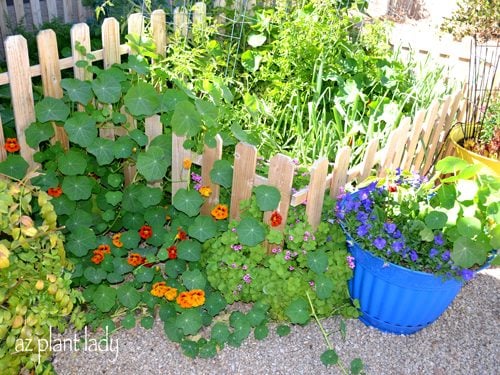
Nasturtiums (Tropaeolum) are not only attractive, but they are extremely helpful in the vegetable garden. While their fragrance doesn’t bother humans, damaging insects like squash bugs can’t stand it.
Because of this, I have nasturtiums growing among my veggies (above) every spring. They really do help to keep garden pests away from my vegetables, especially my tomatoes.

There are many other reasons to include nasturtiums in your garden. The edible flowers are great to include in salads when grown organically. They have a peppery taste. The rounded green leaves are also attractive and edible.
Nasturtium seeds are quite large and easy to grow, which makes them a great gardening project for kids to do. Simply plant a packet of nasturtium seeds in spring, once the danger of frost is past, in a sunny area. Seedling will appear in a little over a week. They are simple to care for with regular watering.
Their nectar attracts plenty of pollinators, including moths, butterflies and hummingbirds.
Nasturtium Care and Growing Tips
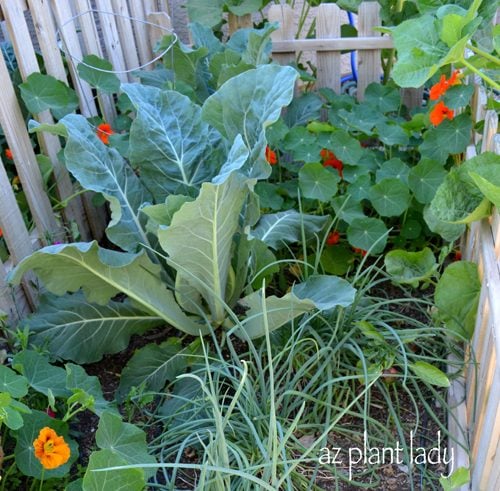
Nasturtiums aren’t fussy plants and they thrive in poor, rocky and non-fertile soils. However, they are still recommended for vegetable gardens with fertile soil because of their insect repellent qualities. You won’t get as many flowers, but the leaves are very attractive by themselves.
Nasturtiums are available in climbing, dwarf and traditional forms. You can also find varieties in a multitude of colors such as yellow, orange, pink and red. Try the award-winning Baby Rose for rosy colored blooms.
They can grow vertically up a trellis and look great spilling out of a container. The traditional forms make great bedding plants.

In hot summer areas like mine, nasturtiums die off in the summer. I just let them go to seed and they often grow back the following spring. You can also collect the seed and plant them in other areas.
It’s hard to find a better annual flower for the garden—beautiful edible blooms, easy to grow, keeps damaging insects away, and cheap! Spend a few dollars on a packet of seeds and you’ll soon be enjoying the many benefits of nasturtiums this spring.
Next, learn why you should add sweet alyssum to spring containers.
Sarah Bernhardt Peony Care

Introduced in 1906, the Sarah Bernhardt peony takes its name from an iconic silent film era actress. This stunning, hardy perennial plant is beloved by gardeners for good reason. Get care and growing tips, plus learn what the flowers and foliage look like.
Enjoy pretty pictures of peonies in full bloom.
- Scientific name: Paeonia lactiflora
- Zones: 3 to 8
- Size: 3 feet high by 2 1/2 feet wide
- Light Needs: Full Sun
- Soil: Average, well-draining
Like other peonies, Sarah Bernhardt prefers rich, well-drained soil and full sun. Plant peonies in fall for the best results. They need a period of cold weather (but not ants) in order to bloom.
Water deeply and regularly in the first growing season to develop a substantial root system. Once your new plant is established, you can water less frequently. Trim off spent blooms after the glorious late spring flower show and cut the foliage back in fall.
Herbaceous peonies such as Sarah Bernhardt are reliable, low maintenance perennials that can live for decades in your garden (up to 100 years!), so you’ll enjoy their beauty and elegance for many, many growing seasons to come. Unlike other perennials, such as hostas, peonies do not need regular dividing.
You may need garden stakes to support the large double flowers.
Get more tips on how to grow and care for peony flowers.
Fragrant Pink Flowers

You’ll definitely want to add Sarah Bernhardt peonies to your cutting garden. The long lasting blooms are a fantastic choice for bouquets or arrangements in vases. The fragrant 7-t0 8-inch flowers are rose-pink in color and pale blush near the edges. A few petals may be flecked with crimson.
Bees love peonies, but deer and rabbits typically leave the emerald green foliage alone.
Grow a fernleaf peony for fancy flowers and foliage.
Where to Buy a Sarah Bernhardt Peony

Check your local garden center or plant nursery. This popular pink peony is also available from several online growers, including Breck’s and Burpee. For bold fuchsia colored flowers, try Red Sarah Bernhardt.
Next, discover 10 little-known peony plant facts.
Sweet Alyssum Care and Growing Tips
Allow me to introduce you to one of my favorite cool-season annuals: sweet alyssum.
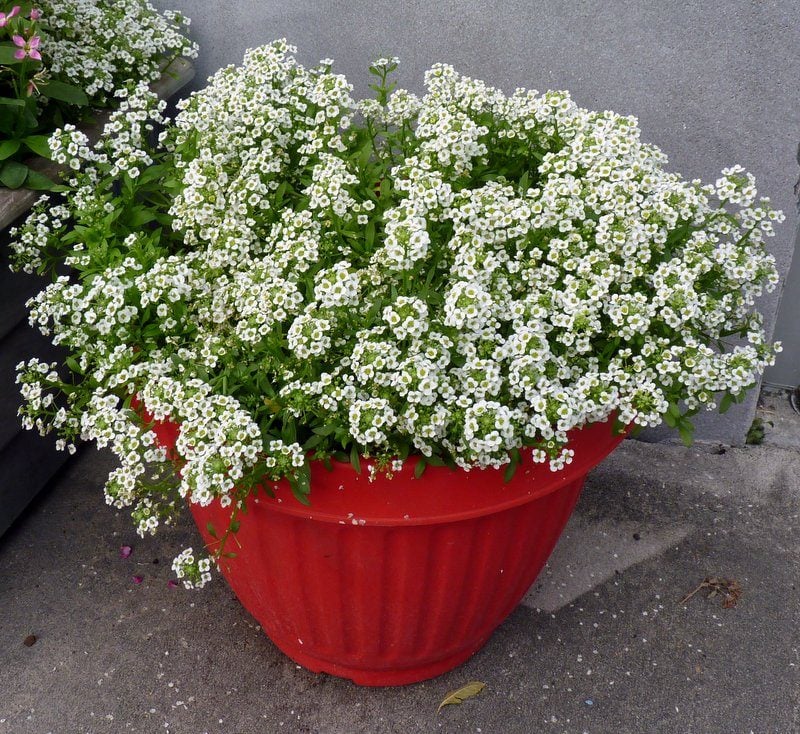
This low-growing beauty is native to the Mediterranean region (hence the botanical name (Lobularia maritima). It will thrive in just about any garden as long as the temperatures remain fairly cool and the humidity isn’t too high. Folks in the south can grow it in the winter and spring. Those up north can delight in it all summer long.
The flowers have a very strong honey-like fragrance which most people enjoy, although there are those who don’t care for the scent. They grow well from seed, blooming in just 6 to 8 weeks.
I find alyssum works well as a border plant at the edge of garden beds, and I also find it especially well-suited to containers. It looks lovely as it grows and spills over the sides, and it mixes well with other spring and summer annuals.
Small butterflies and pollinators like bees are drawn to it, making this flowering annual a great choice for your butterfly garden.
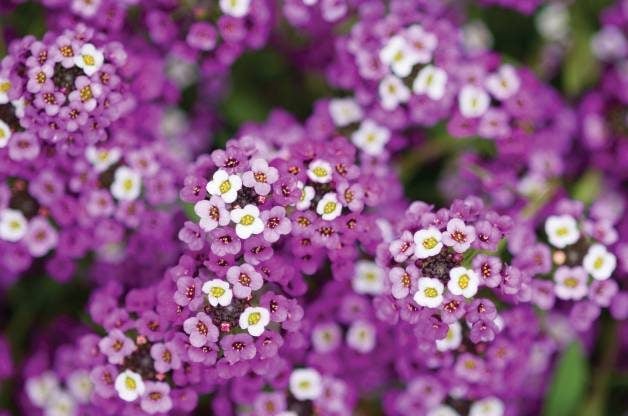
Sweet alyssum should not be confused with gold alyssum (Aurinia saxatilis), a perennial best suited to rock gardens. Sweet alyssum likes full or part sun, and flowers best with regular water in well-drained soil. It may reseed itself in more temperate climates, although heavily wet summers usually prevent that in the southeast. It is available in white and also in a purple/pink combination which isn’t quite as strongly scented and is noted by many to have fewer flowers.
Check out our favorite white flowers to make your garden glow.
Container Combinations
The small flowers complement almost any other annuals that you love. Here are some of the combinations I’m using this year.
Yellow Marigold
Dwarf Snapdragon
Dwarf Stock
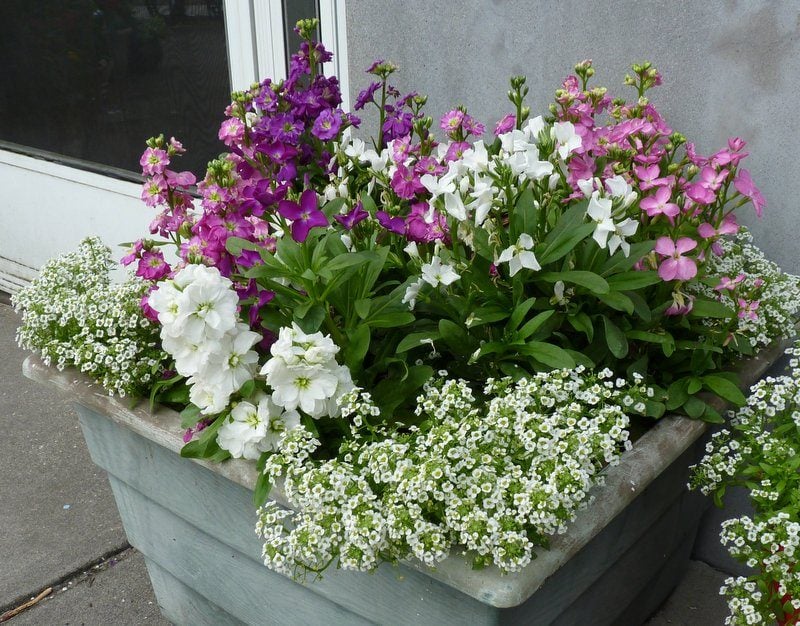
Yellow Bidens
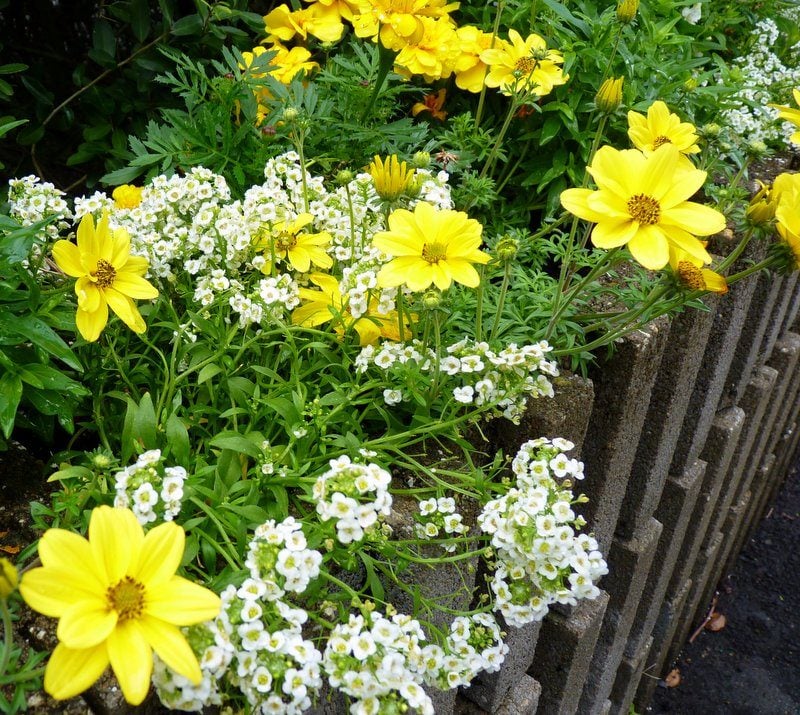
What Makes Fernleaf Peonies Unique?

Fernleaf peony (Paeonia tenuifolia) leaves offer a distinctive and spiffy twist on an old-fashioned garden favorite. The plant’s leafy, thin foliage mimics that of a fern, making them a standout even among the most gorgeous peonies. They’re often referred to as “Mother’s Day” peonies because of their early bloom time, and they keep their flowers for about a week. When the blooms are spent, it’s a good idea to trim them back.
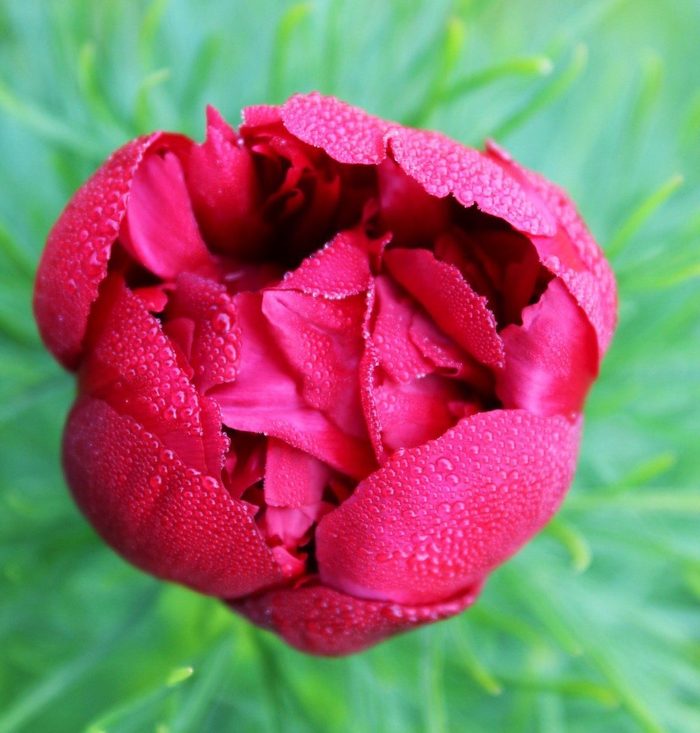
Find out when you should plant peonies during the year for those delightful spring and summer blooms.
Early Scout Fernleaf Peony Hybrid: Growing Tips

Common Name: Early Scout Fernleaf Peony
Scientific Name: Paeonia hybrid ‘Early Scout’
Zones: 3 to 8
Size: 2 feet tall and wide
Soil: Moist
Light Needs: Full sun to part shade
Attracts: Butterflies
“Early scout” fernleaf is a popular, award-winning peony hybrid (Paeonia ‘Richard Carvel’ x single tenuifolia). It grows best in moist, well-draining soil and tolerates a variety of light conditions, including full sun, part sun, and part shade. Just after planting, it’s best to give your new peony plenty of water to help it get established—later on, it won’t require too much watering. Gardeners should remove spent blooms and then cut back the foliage in the fall.
Learn how to treat botrytis blight disease on peonies.
Benefits of Planting Early Scout
What’s in a name? In this case, it’s the perks of growing an Early Scout fernleaf peony. The biggest benefit for the winter-weary resides in that first word: early. This peony is one of the earliest hybrid peonies to bloom during the growing season, bearing its crimson colored flowers in late spring or early summer. Its leaves boast an eye-catching fern shape, and the flowers make it a great addition to a cutting garden.
Plus, the plant is deer-resistant, and the flowers will attract plenty of pollinators.
Next, check out 10 peony arrangements and gifts to send this spring.
To put it simply, the Bullock’s oriole is a bewitching bird if you’re lucky enough to spot one. “Everybody is excited to see such a charismatic, beautiful species,” says Boaz “Bo” Crees, an avian specialist for both the Montana Natural Heritage Program and Montana Audubon.
Check out the 8 types of orioles to look for in North America.
Male and Female Bullock’s Orioles
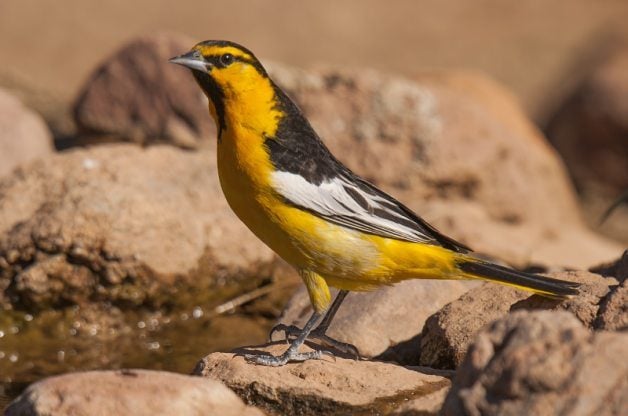
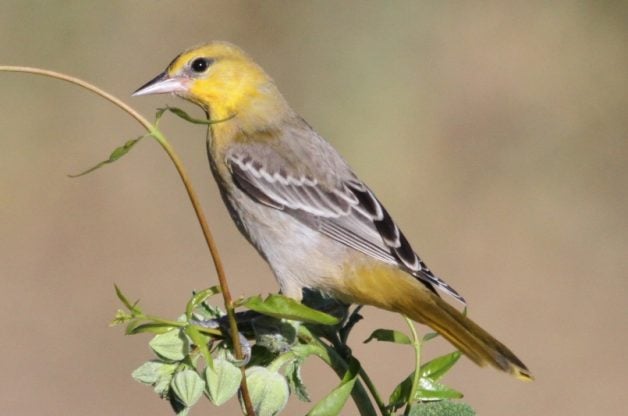
Baltimore and Bullock’s orioles are often confused for one another because of their similar colorings. In both species, males feature black on their heads and backs. A key difference is that Bullock’s orioles “have a black eyeline against an orange cheek, instead of an all-black head,” Bo says.
Female Bullock’s are more muted, with yellowish orange heads and throats, whitish bellies and grayish backs. Both males and females sport large white wing bars and measure about 8 inches long with a 12 inch wingspan.
Scientific Name: Icterus bullockii
Family: Blackbird
Learn 7 surprising Baltimore oriole facts.
Bullock’s Oriole Nesting Habits

This species weaves a bag-like structure in a tree and lays three to seven eggs inside. Pairs use natural fibers to create gourd-shaped houses that dangle up to 25 feet off the ground.
Nest construction can take up to 15 days. Discover how orioles weave their elaborate nests.
What Do Bullock’s Orioles Eat?
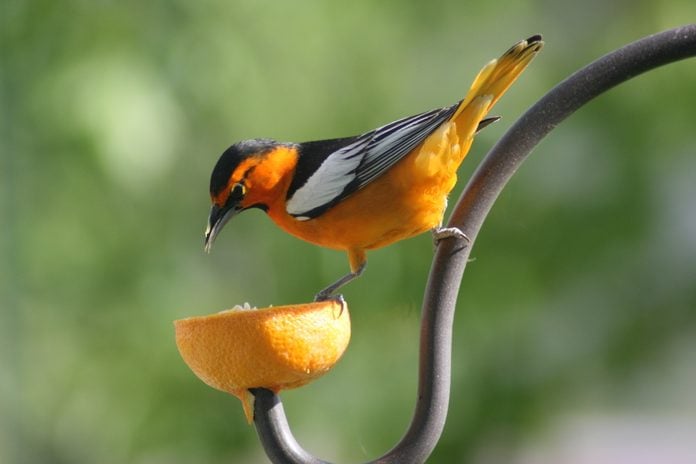
Orioles are brought to feeders by familiar fruity fare: orange wedges, grapes, bananas, berries and apples. And at times they’ll also stop at a sugar-water feeder or sample fruit-filled suet. Bullock’s orioles also eat insects. “They have a fairly slender beak that’s a really good tweezer for picking up grubs or getting nectar,” Bo says.

Bullock’s are in the U.S. only during their breeding season. To spot an oriole during migration, set out supper early in spring to increase your chances. The Cornell Lab of Ornithology recommends that you “start putting out food before migrants arrive in your area; if it’s not there when they first canvas your yard, they’ll keep going.”
“Bullock’s orioles nest in our big willow tree every spring. They build a hanging nest and usually raise two chicks. They love grape jelly, and this is a young male (above) that comes by for a treat,” says reader Laura Dent.
Get more tips on how to attract orioles.
Bullock’s Oriole Song

Bullock’s orioles produce noises ranging from rich whistling songs to gruff, scratchy notes and rattles. Listen to this bird’s song to help you identify them.
Bird songs provided by the Cornell Lab of Ornithology.
Learn what a Baltimore oriole song sounds like.
Range and Habitat

Baltimore orioles are seen in the eastern United States, while Bullock’s are found throughout much of the West beyond the Great Plains. That said, these two orioles do hybridize on the Great Plains. At one point, they were lumped together under the name northern oriole before being split into two separate species.
During migration, take a nature walk near water if you want to spot these birds. “If you see a cottonwood tree and vibrant orange, you’ve likely got an oriole on your hands,” Bo says, noting that orioles particularly like woodlands near water. Also check sycamores and willows for oriole indications. Those resource-rich trees offer orioles some concealing cover, abundant insects and copious materials for their intricately woven hanging nests.
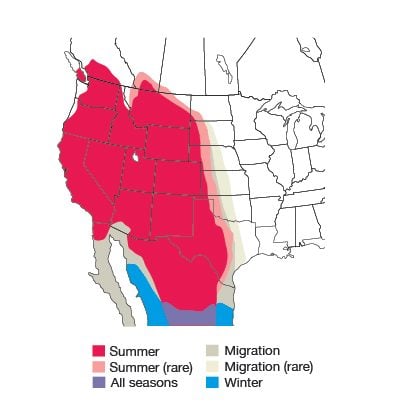
Range maps provided by Kaufman Field Guides, the official field guide of Birds & Blooms.
Next, learn how to identify orchard orioles.
